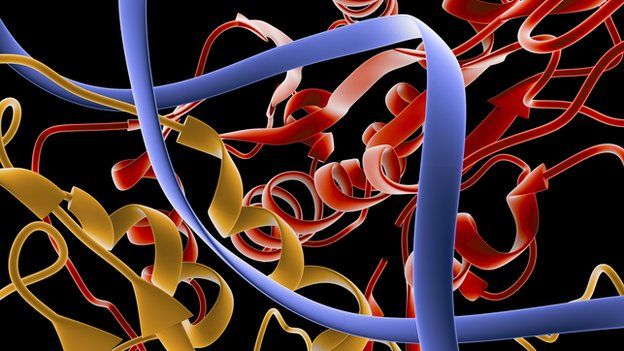Scientists make enzymes from scratch
- Published

Experts say they have achieved a scientific milestone - creating enzymes out of artificial genetic material that they made in their lab.
The synthetic enzymes functioned just as well as real ones.
The work, in Nature journal, not only provides clues to the building blocks of life but also points to a new way to make therapeutic drugs for humans.
The UK Medical Research Council team now hopes to make more complex structures that rival nature.
Genetic information
The ground work for the pioneering project started a couple of years ago when Dr Philipp Holliger and his team created synthetic versions of DNA and its chemical cousin RNA - the molecules that carry the basic genetic code of life.
Using these artificial XNAs as building blocks, the researchers set out to see if they could make synthetic enzymes - substances that drive a wide range of bodily functions, such as how we digest our food.
Dr Holliger explained: "Until recently, it was thought that DNA and RNA were the only molecules that could store genetic information and, together with proteins, the only biomolecules able to form enzymes."
His team found it was possible to create enzymes from scratch using material that does not exist in nature.
Although entirely man-made, the synthetic enzymes are capable of building and breaking down molecules - just like naturally occurring ones.
The "XNAzymes", as the researchers call them, could jump-start simple reactions, such as cutting and joining RNA strands in a test tube.
One of the XNAzymes joined XNA strands together - something that represents one of the first steps to creating a living system, say scientists.
Dr Holliger said: "Our work suggests that, in principle, there are a number of possible alternatives to nature's molecules that will support the catalytic processes required for life. Life's 'choice' of RNA and DNA may just be an accident of prehistoric chemistry."
He said it was possible that life could be found on other planets, born from a molecular "backbone" other than DNA.
Back here on Earth, synthetic enzymes might be useful for treating human diseases such as cancer.
Dr Holliger explained that XNAs are ideally suited as a therapy.
Chemically, they are extremely hardy and, because they do not occur in nature, they can evade the body's natural degrading enzymes.
"This might make them an attractive candidate for long-lasting treatments that can disrupt disease-related RNAs," he said.
"And because we can modify chemistry at least to some extent to our hearts' content, we can make tailor-made enzymes for particular purposes."
Prof Paul Freemont, an expert in structural biology at Imperial College London, said: "I can see how there could be therapeutic strategies downstream if we can start to mimic nature and develop synthetic variants.
"What excites me more is the questions it raises about the origins of life. It provokes people to think that what we see on our planet is just one chemical possibility. It's the pure challenge of the chemistry of life."
- Published27 March 2014
- Published19 April 2012